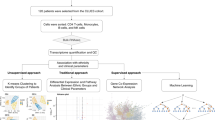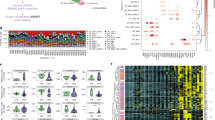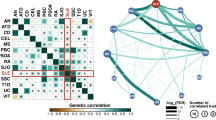Abstract
Gene-expression profiling is a powerful tool for the discovery of molecular fingerprints that underlie human disease. Microarray technologies allow the analysis of messenger RNA transcript levels for every gene in the genome. However, gene-expression profiling is best viewed as part of a pipeline that extends from sample collection through clinical application. Key genes and pathways identified by microarray profiling should be validated in independent sample sets and with alternative technologies. Analysis of relevant signaling pathways at the protein level is an important step towards understanding the functional consequences of aberrant gene expression. Peripheral blood is a convenient and rich source of potential biomarkers, but surveying purified cell populations and target tissues can also enhance our understanding of disease states. In rheumatic disease, probing the transcriptome of circulating immune cells has shed light on mechanisms underlying the pathogenesis of complex diseases, such as systemic lupus erythematosus. As these discoveries advance through the pipeline, a variety of clinical applications are on the horizon, including the use of molecular fingerprints to aid in diagnosis and prognosis, improved use of existing therapies, and the development of drugs that target relevant genes and pathways.
Key Points
-
Gene-expression profiling is part of a pipeline that has led to identification of promising biomarkers in rheumatology
-
Sample collection and clinical end points must be considered at an early stage to ensure that high-quality samples and appropriate clinical data are collected
-
Genes and pathways identified by microarray analysis should be validated in independent sample collections and by alternative methods
-
Key genes and pathways identified in gene-expression studies can be examined at the protein level using a variety of multiplexed platforms
This is a preview of subscription content, access via your institution
Access options
Subscribe to this journal
Receive 12 print issues and online access
$209.00 per year
only $17.42 per issue
Buy this article
- Purchase on Springer Link
- Instant access to full article PDF
Prices may be subject to local taxes which are calculated during checkout


Similar content being viewed by others
References
Baechler, E. C. et al. Expression levels for many genes in human peripheral blood cells are highly sensitive to ex vivo incubation. Genes Immun. 5, 347–353 (2004).
Liu, J., Walter, E., Stenger, D. & Thach, D. Effects of globin mRNA reduction methods on gene expression profiles from whole blood. J. Mol. Diagn. 8, 551–558 (2006).
Hashimoto, A. et al. Laser-mediated microdissection for analysis of gene expression in synovial tissue. Mod. Rheumatol. 17, 185–190 (2007).
Hoffmann, M. et al. Robust computational reconstitution—a new method for the comparative analysis of gene expression in tissues and isolated cell fractions. BMC Bioinformatics 7, 369 (2006).
Judex, M. et al. Laser-mediated microdissection facilitates analysis of area-specific gene expression in rheumatoid synovium. Arthritis Rheum. 48, 97–102 (2003).
Tsubaki, T. et al. Characterization of histopathology and gene-expression profiles of synovitis in early rheumatoid arthritis using targeted biopsy specimens. Arthritis Res. Ther. 7, R825–R836 (2005).
Ueda, H. et al. Association of the T-cell regulatory gene CTLA4 with susceptibility to autoimmune disease. Nature 423, 506–511 (2003).
Haas, C. S. et al. Identification of genes modulated in rheumatoid arthritis using complementary DNA microarray analysis of lymphoblastoid B cell lines from disease-discordant monozygotic twins. Arthritis Rheum. 54, 2047–2060 (2006).
Baumann, S. et al. Standardized approach to proteome profiling of human serum based on magnetic bead separation and matrix-assisted laser desorption/ionization time-of-flight mass spectrometry. Clin. Chem. 51, 973–980 (2005).
Illei, G. G., Tackey, E., Lapteva, L. & Lipsky, P. E. Biomarkers in systemic lupus erythematosus: II. Markers of disease activity. Arthritis Rheum. 50, 2048–2065 (2004).
Brown, P. O. & Botstein, D. Exploring the new world of the genome with DNA microarrays. Nat. Genet. 21, 33–37 (1999).
Schena, M., Shalon, D., Davis, R. W. & Brown, P. O. Quantitative monitoring of gene expression patterns with a complementary DNA microarray. Science 270, 467–470 (1995).
Van Gelder, R. N. et al. Amplified RNA synthesized from limited quantities of heterogeneous cDNA. Proc. Natl Acad. Sci. USA 87, 1663–1667 (1990).
Wang, E., Miller, L. D., Ohnmacht, G. A., Liu, E. T. & Marincola, F. M. High-fidelity mRNA amplification for gene profiling. Nat. Biotechnol. 18, 457–459 (2000).
Stirewalt, D. L. et al. Single-stranded linear amplification protocol results in reproducible and reliable microarray data from nanogram amounts of starting RNA. Genomics 83, 321–331 (2004).
Marioni, J. C., Mason, C. E., Mane, S. M., Stephens, M. & Gilad, Y. RNA-seq: an assessment of technical reproducibility and comparison with gene expression arrays. Genome Res. 18, 1509–1517 (2008).
Pan, Q., Shai, O., Lee, L. J., Frey, B. J. & Blencowe, B. J. Deep surveying of alternative splicing complexity in the human transcriptome by high-throughput sequencing. Nat. Genet. 40, 1413–1415 (2008).
Wang, Z., Gerstein, M. & Snyder, M. RNA-Seq: a revolutionary tool for transcriptomics. Nat. Rev. Genet. 10, 57–63 (2009).
Simon, S. A. et al. Short-read sequencing technologies for transcriptional analyses. Annu. Rev. Plant Biol. [doi:10.1146/annurev.arplant.043008.092032] (2009).
't Hoen, P. A. et al. Deep sequencing-based expression analysis shows major advances in robustness, resolution and inter-lab portability over five microarray platforms. Nucleic Acids Res. 36, e141 (2008).
Ioannidis, J. P. Microarrays and molecular research: noise discovery? Lancet 365, 454–455 (2005).
Simon, R., Radmacher, M. D. & Dobbin, K. Design of studies using DNA microarrays. Genet. Epidemiol. 23, 21–36 (2002).
Liang, Y. & Kelemen, A. Associating phenotypes with molecular events: recent statistical advances and challenges underpinning microarray experiments. Funct. Integr. Genomics 6, 1–13 (2006).
Arya, M. et al. Basic principles of real-time quantitative PCR. Expert Rev. Mol. Diagn. 5, 209–219 (2005).
Huggett, J., Dheda, K., Bustin, S. & Zumla, A. Real-time RT-PCR normalisation; strategies and considerations. Genes Immun. 6, 279–284 (2005).
May, M. Life science technologies: qPCR—making older technology new again. Science 321, 1696–1699 (2008).
Provenzano, M. & Mocellin, S. Complementary techniques: validation of gene expression data by quantitative real time PCR. Adv. Exp. Med. Biol. 593, 66–73 (2007).
VanGuilder, H. D., Vrana, K. E. & Freeman, W. M. Twenty-five years of quantitative PCR for gene expression analysis. Biotechniques 44, 619–626 (2008).
Marras, S. A., Tyagi, S. & Kramer, F. R. Real-time assays with molecular beacons and other fluorescent nucleic acid hybridization probes. Clin. Chim. Acta 363, 48–60 (2006).
Solinas, A. et al. Duplex Scorpion primers in SNP analysis and FRET applications. Nucleic Acids Res. 29, E96 (2001).
Lyng, M. B. et al. Intratumor genetic heterogeneity of breast carcinomas as determined by fine needle aspiration and TaqMan low density array. Cell. Oncol. 29, 361–372 (2007).
Yoshida, T., Jiang, F., Honjo, T. & Okazaki, T. PD-1 deficiency reveals various tissue-specific autoimmunity by H-2b and dose-dependent requirement of H-2g7 for diabetes in NOD mice. Proc. Natl Acad. Sci. USA 105, 3533–3538 (2008).
Ismail, A. A., Walker, P. L., Cawood, M. L. & Barth, J. H. Interference in immunoassay is an underestimated problem. Ann. Clin. Biochem. 39, 366–373 (2002).
Balboni, I. et al. Multiplexed protein array platforms for analysis of autoimmune diseases. Annu. Rev. Immunol. 24, 391–418 (2006).
Fathman, C. G., Soares, L., Chan, S. M. & Utz, P. J. An array of possibilities for the study of autoimmunity. Nature 435, 605–611 (2005).
Slamon, D. J. et al. Human breast cancer: correlation of relapse and survival with amplification of the HER-2/neu oncogene. Science 235, 177–182 (1987).
Slamon, D. J. et al. Studies of the HER-2/neu proto-oncogene in human breast and ovarian cancer. Science 244, 707–712 (1989).
Nuyten, D. S. & van de Vijver, M. J. Using microarray analysis as a prognostic and predictive tool in oncology: focus on breast cancer and normal tissue toxicity. Semin. Radiat. Oncol. 18, 105–114 (2008).
Bomprezzi, R. et al. Gene expression profile in multiple sclerosis patients and healthy controls: identifying pathways relevant to disease. Hum. Mol. Genet. 12, 2191–2199 (2003).
Sturzebecher, S. et al. Expression profiling identifies responder and non-responder phenotypes to interferon-β in multiple sclerosis. Brain 126, 1419–1429 (2003).
Baechler, E. C. et al. Interferon-inducible gene expression signature in peripheral blood cells of patients with severe lupus. Proc. Natl Acad. Sci. USA 100, 2610–2615 (2003).
Bennett, L. et al. Interferon and granulopoiesis signatures in systemic lupus erythematosus blood. J. Exp. Med. 197, 711–723 (2003).
Maas, K. et al. Cutting edge: molecular portrait of human autoimmune disease. J. Immunol. 169, 5–9 (2002).
Stoeckman, A. K. et al. A distinct inflammatory gene expression profile in patients with psoriatic arthritis. Genes Immun. 7, 583–591 (2006).
Batliwalla, F. M. et al. Microarray analyses of peripheral blood cells identifies unique gene expression signature in psoriatic arthritis. Mol. Med. 11, 21–29 (2005).
Batliwalla, F. M. et al. Peripheral blood gene expression profiling in rheumatoid arthritis. Genes Immun. 6, 388–397 (2005).
van der Pouw Kraan, T. C. et al. Rheumatoid arthritis subtypes identified by genomic profiling of peripheral blood cells: assignment of a type I interferon signature in a subpopulation of patients. Ann. Rheum. Dis. 66, 1008–1014 (2007).
Koczan, D. et al. Gene expression profiling of peripheral blood mononuclear leukocytes from psoriasis patients identifies new immune regulatory molecules. Eur. J. Dermatol. 15, 251–257 (2005).
Petty, R. E. et al. International League of Associations for Rheumatology classification of juvenile idiopathic arthritis: second revision, Edmonton, 2001. J. Rheumatol. 31, 390–392 (2004).
Pascual, V., Allantaz, F., Arce, E., Punaro, M. & Banchereau, J. Role of interleukin-1 (IL-1) in the pathogenesis of systemic onset juvenile idiopathic arthritis and clinical response to IL-1 blockade. J. Exp. Med. 201, 1479–1486 (2005).
Adams, A. & Lehman, T. J. Update on the pathogenesis and treatment of systemic onset juvenile rheumatoid arthritis. Curr. Opin. Rheumatol. 17, 612–616 (2005).
Buch, M. H. et al. Lack of response to anakinra in rheumatoid arthritis following failure of tumor necrosis factor alpha blockade. Arthritis Rheum. 50, 725–728 (2004).
Genovese, M. C. et al. Combination therapy with etanercept and anakinra in the treatment of patients with rheumatoid arthritis who have been treated unsuccessfully with methotrexate. Arthritis Rheum. 50, 1412–1419 (2004).
Kirou, K. A. et al. Coordinate overexpression of interferon-α-induced genes in systemic lupus erythematosus. Arthritis Rheum. 50, 3958–3967 (2004).
Baechler, E. C., Gregersen, P. K. & Behrens, T. W. The emerging role of interferon in human systemic lupus erythematosus. Curr. Opin. Immunol. 16, 801–807 (2004).
Kirou, K. A. et al. Activation of the interferon-α pathway identifies a subgroup of systemic lupus erythematosus patients with distinct serologic features and active disease. Arthritis Rheum. 52, 1491–1503 (2005).
Bauer, J. W. et al. Elevated serum levels of interferon-regulated chemokines are biomarkers for active human systemic lupus erythematosus. PLoS Med. 3, e491 (2006).
Banchereau, J. & Pascual, V. Type I interferon in systemic lupus erythematosus and other autoimmune diseases. Immunity 25, 383–392 (2006).
Blomberg, S. et al. Presence of cutaneous interferon-α producing cells in patients with systemic lupus erythematosus. Lupus 10, 484–490 (2001).
Fah, J., Pavlovic, J. & Burg, G. Expression of MxA protein in inflammatory dermatoses. J. Histochem. Cytochem. 43, 47–52 (1995).
Peterson, K. S. et al. Characterization of heterogeneity in the molecular pathogenesis of lupus nephritis from transcriptional profiles of laser-captured glomeruli. J. Clin. Invest. 113, 1722–1733 (2004).
Farkas, L., Beiske, K., Lund-Johansen, F., Brandtzaeg, P. & Jahnsen, F. L. Plasmacytoid dendritic cells (natural interferon-α/β-producing cells) accumulate in cutaneous lupus erythematosus lesions. Am. J. Pathol. 159, 237–243 (2001).
Ronnblom, L. & Alm, G. V. A pivotal role for the natural interferon α-producing cells (plasmacytoid dendritic cells) in the pathogenesis of lupus. J. Exp. Med. 194, F59–F63 (2001).
Diebold, S. S., Kaisho, T., Hemmi, H., Akira, S. & Reis e Sousa, C. Innate antiviral responses by means of TLR7-mediated recognition of single-stranded RNA. Science 303, 1529–1531 (2004).
Heil, F. et al. Species-specific recognition of single-stranded RNA via Toll-like receptor 7 and 8. Science 303, 1526–1529 (2004).
Hemmi, H. et al. A Toll-like receptor recognizes bacterial DNA. Nature 408, 740–745 (2000).
Bave, U., Alm, G. V. & Ronnblom, L. The combination of apoptotic U937 cells and lupus IgG is a potent IFN-α inducer. J. Immunol. 165, 3519–3526 (2000).
Lovgren, T., Eloranta, M. L., Bave, U., Alm, G. V. & Ronnblom, L. Induction of interferon-α production in plasmacytoid dendritic cells by immune complexes containing nucleic acid released by necrotic or late apoptotic cells and lupus IgG. Arthritis Rheum. 50, 1861–1872 (2004).
Davies, K. A., Peters, A. M., Beynon, H. L. & Walport, M. J. Immune complex processing in patients with systemic lupus erythematosus. In vivo imaging and clearance studies. J. Clin. Invest. 90, 2075–2083 (1992).
Akira, S. & Takeda, K. Toll-like receptor signalling. Nat. Rev. Immunol. 4, 499–511 (2004).
Pascual, V., Farkas, L. & Banchereau, J. Systemic lupus erythematosus: all roads lead to type I interferons. Curr. Opin. Immunol. 18, 676–682 (2006).
Baechler, E. C. et al. An interferon signature in the peripheral blood of dermatomyositis patients is associated with disease activity. Mol. Med. 13, 59–68 (2007).
Greenberg, S. A. et al. Interferon-α/β-mediated innate immune mechanisms in dermatomyositis. Ann. Neurol. 57, 664–678 (2005).
Lopez de Padilla, C. M. et al. Plasmacytoid dendritic cells in inflamed muscle of patients with juvenile dermatomyositis. Arthritis Rheum. 56, 1658–1668 (2007).
Nomura, I. et al. Distinct patterns of gene expression in the skin lesions of atopic dermatitis and psoriasis: a gene microarray analysis. J. Allergy Clin. Immunol. 112, 1195–1202 (2003).
Oestreicher, J. L. et al. Molecular classification of psoriasis disease-associated genes through pharmacogenomic expression profiling. Pharmacogenomics J. 1, 272–287 (2001).
Coelho, L. F., de Oliveira, J. G. & Kroon, E. G. Interferons and scleroderma—a new clue to understanding the pathogenesis of scleroderma? Immunol. Lett. 118, 110–115 (2008).
Wildenberg, M. E., van Helden-Meeuwsen, C. G., van de Merwe, J. P., Drexhage, H. A. & Versnel, M. A. Systemic increase in type I interferon activity in Sjögren's syndrome: a putative role for plasmacytoid dendritic cells. Eur. J. Immunol. 38, 2024–2033 (2008).
Wallace, D. et al. MEDI-545, an anti-interferon-α monoclonal antibody, shows evidence of clinical activity in systemic lupus erythematosus [Abstract 1315]. Program and abstracts of the American College of Rheumatology 71st Annual Meeting; 6–11 November, 2007; Boston, Massachusetts.
Lettre, G. & Rioux, J. D. Autoimmune diseases: insights from genome-wide association studies. Hum. Mol. Genet. 17, R116–R121 (2008).
Merrill, J. T., Erkan, D. & Buyon, J. P. Challenges in bringing the bench to bedside in drug development for SLE. Nat. Rev. Drug Discov. 3, 1036–1046 (2004).
Shirota, Y., Illei, G. G. & Nikolov, N. P. Biologic treatments for systemic rheumatic diseases. Oral Dis. 14, 206–216 (2008).
Mease, P. J. B cell-targeted therapy in autoimmune disease: rationale, mechanisms, and clinical application. J. Rheumatol. 35, 1245–1255 (2008).
Calabrese, L. H., Molloy, E. S., Huang, D. & Ransohoff, R. M. Progressive multifocal leukoencephalopathy in rheumatic diseases: evolving clinical and pathologic patterns of disease. Arthritis Rheum. 56, 2116–2128 (2007).
Filipowicz, W., Bhattacharyya, S. N. & Sonenberg, N. Mechanisms of post-transcriptional regulation by microRNAs: are the answers in sight? Nat. Rev. Genet. 9, 102–114 (2008).
Dai, Y. et al. Microarray analysis of microRNA expression in peripheral blood cells of systemic lupus erythematosus patients. Lupus 16, 939–946 (2007).
Engvall, E., Jonsson, K. & Perlmann, P. Enzyme-linked immunosorbent assay. II. Quantitative assay of protein antigen, immunoglobulin G, by means of enzyme-labelled antigen and antibody-coated tubes. Biochim. Biophys. Acta 251, 427–434 (1971).
Engvall, E. & Perlman, P. Enzyme-linked immunosorbent assay (ELISA). Quantitative assay of immunoglobulin G. Immunochemistry 8, 871–874 (1971).
Perlee, L. et al. Development and standardization of multiplexed antibody microarrays for use in quantitative proteomics. Proteome Sci. 2, 9 (2004).
Fulton, R. J., McDade, R. L., Smith, P. L., Kienker, L. J. & Kettman, J. R. Jr Advanced multiplexed analysis with the FlowMetrix system. Clin. Chem. 43, 1749–1756 (1997).
Kingsmore, S. F. Multiplexed protein measurement: technologies and applications of protein and antibody arrays. Nat. Rev. Drug Discov. 5, 310–320 (2006).
Mendoza, L. G. et al. High-throughput microarray-based enzyme-linked immunosorbent assay (ELISA). Biotechniques 27, 778–788 (1999).
Author information
Authors and Affiliations
Corresponding author
Ethics declarations
Competing interests
Emily C. Baechler is a co-inventor on the following patent: Behrens, T., Baechler; E. C., Gregersen, P. K. Methods for diagnosing severe systemic lupus erythematosus. US Patent 7,118,865 (2006).
Rights and permissions
About this article
Cite this article
Bauer, J., Bilgic, H. & Baechler, E. Gene-expression profiling in rheumatic disease: tools and therapeutic potential. Nat Rev Rheumatol 5, 257–265 (2009). https://doi.org/10.1038/nrrheum.2009.50
Issue Date:
DOI: https://doi.org/10.1038/nrrheum.2009.50
This article is cited by
-
Gene Expression Profiling Studies Using Microarray in Osteoarthritis: Genes in Common and Different Conditions
Archivum Immunologiae et Therapiae Experimentalis (2020)
-
Microarray study of gene expression profile to identify new candidate genes involved in the molecular mechanism of leptin-induced knee joint osteoarthritis in rat
Hereditas (2018)
-
Microarray analysis after adipose derived mesenchymal stem cells injection in monosodium iodoacetate-induced osteoarthritis rats
Genes & Genomics (2018)
-
Unique gene expression profile in osteoarthritis synovium compared with cartilage: analysis of publicly accessible microarray datasets
Rheumatology International (2016)
-
Blood gene expression profiling in pediatric systemic lupus erythematosus and systemic juvenile idiopathic arthritis: from bench to bedside
Pediatric Rheumatology (2014)



